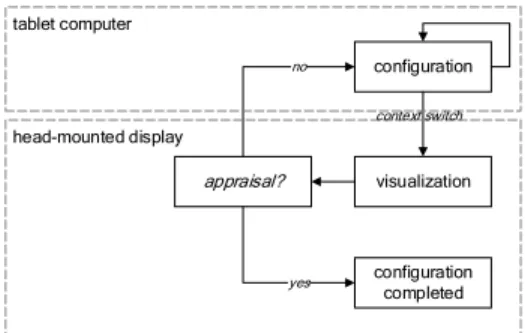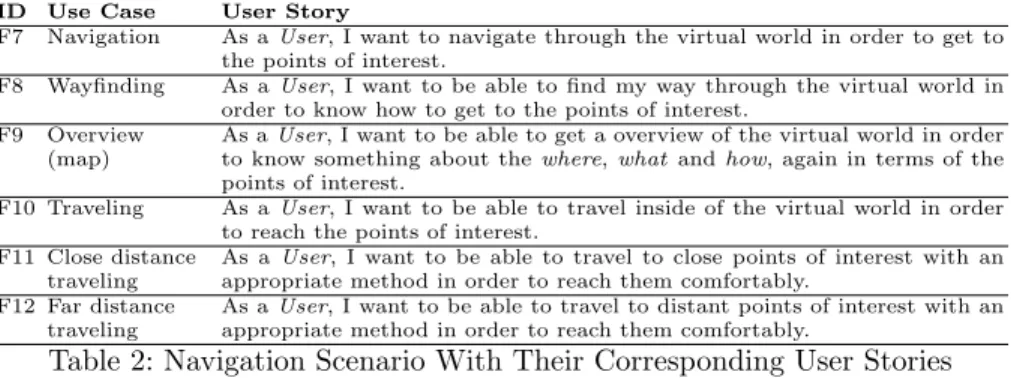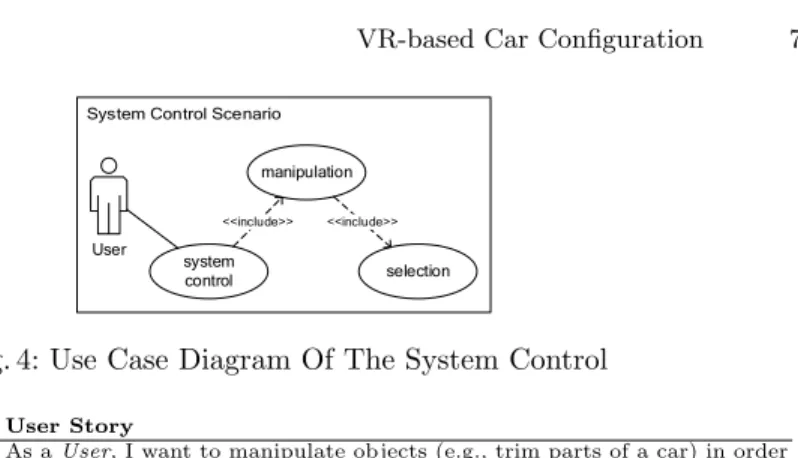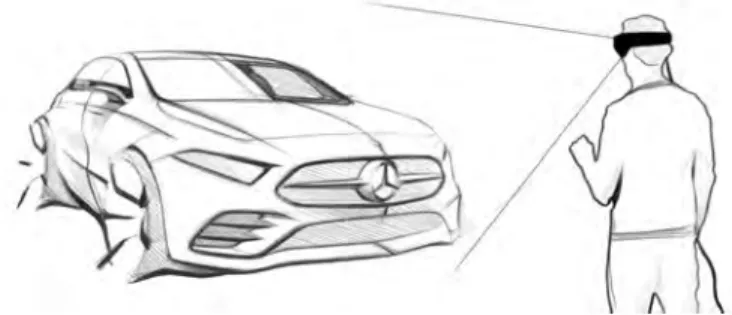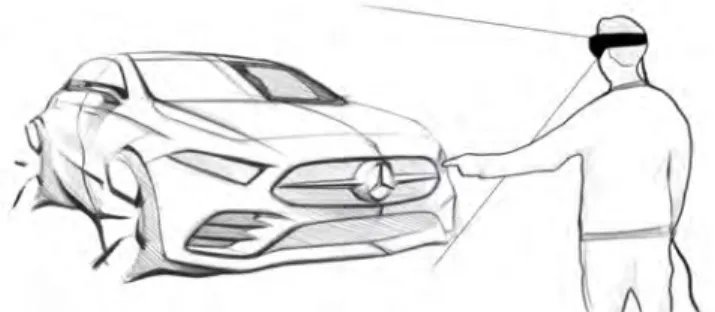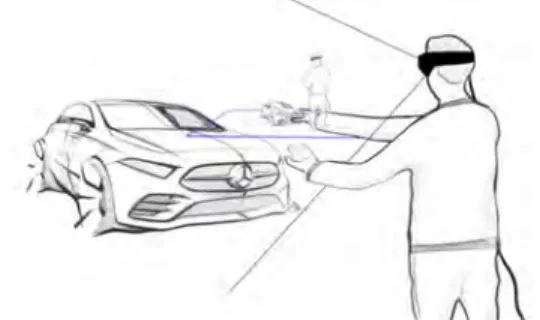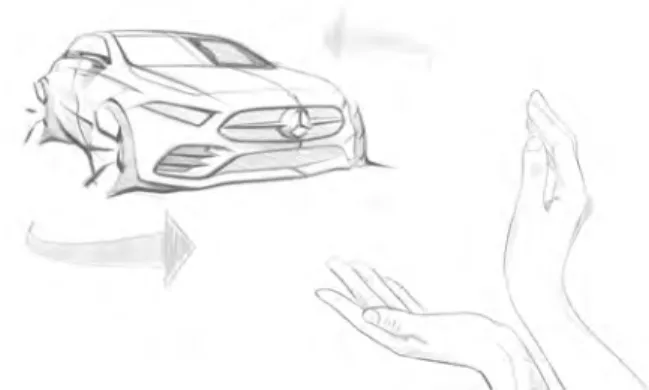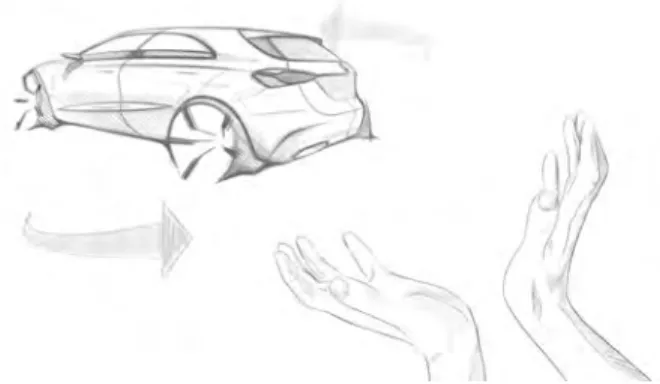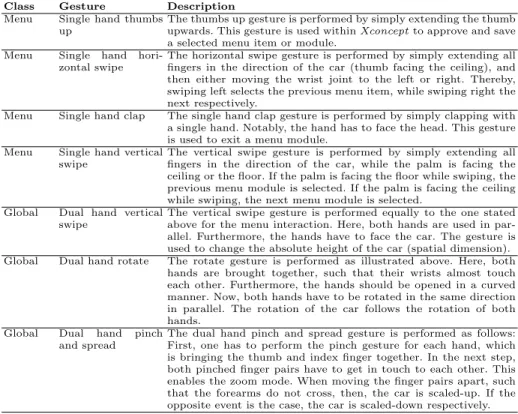Reality-Based Car Configuration Concept
Marcus Korinth1, Thomas Sommer-Dittrich1, Manfred Reichert2, and R¨udiger Pryss2
1 Daimler AG, Ulm, Germany,
marcus.korinth@daimler.com, thomas.sommer-dittrich@daimler.com
2 Ulm University, Ulm, Germany, Institute of Databases and Information Systems, manfred.reichert@uni-ulm.de, ruediger.pryss@uni-ulm.de
Abstract. The Daimler AG provided a concept preview towards the individualization of interior trim parts at theInternational Motor Show in September 2017, which was namedunleash the color. At the show, a tablet computer was used to enable the configuration of a car. The config- uration output, in turn, could be either directly previewed on the tablet computer or experienced using a virtual reality application. However, as the car configuration procedure is usually performed iteratively, a user experiences frequent context switches of the used software application, which often leads to an embittered perceived user experience and usabil- ity. To remedy these drawbacks, one promising approach constitutes the idea to integrate the configuration procedure into a proper virtual real- ity application. The work at hand presentsXconcept, which draws upon various state-of-the-art approaches from the field of human-computer in- teraction to provide a suitable car configuration procedure based on a virtual reality setting. Among other important factors, one fundamen- tal goal ofXconcept constitutes the perceived user experience indepen- dently of age, gender, or previous virtual reality experiences. To evaluate whether or not this can be achieved withXconcept, we conducted a study with employees of the Daimler AG. Although the results of the study re- veal that with rising age, the rating of the Xconcept deteriorates, the overall user experience and usability has been rated positively. Interest- ingly, gender and previous experiences with virtual reality applications had no significant effect on the rating of the user experience. Altogether, Xconceptshows valuable insights to ease the car configuration procedure based on a proper virtual reality setting.
Keywords: car configuration, virtual reality, user study
1 Introduction
Today’s huge demand for various affordable products can only be satisfied by mass production, which was made possible by automation and their technologi- cal advances in the past decades. Especially the mass production of automobiles
had great impact on the economy and accelerated the growth of multiple new industries. However, one major downside of today’s automation is that the di- versity of variants is limited to a given set, i.e., a pre-customizing approach is applied, which results in a lack of (self-)customization and individualization of a product, especially a high-tech one, such as a car. The problem intensifies even further when considering cultural differences between the local markets and the resulting requirements in terms of customization. One predominant cause among others are the inflexible standardized processes and methods, which are necessary in the wake of mass production. However, recent advances in the field of digi- talization might harbor the answer to the customization problem, which could satisfy the human need for individualization [1].
In the context of individualization demands, in September 2017, the Smart division of the Daimler AG introduced a new approach, which was named unleash the color, towards the individualization (and therefore the mass customization) of interior trim parts at the International Motor Show (IAA). With unleash the color, which, in turn, was made possible based on an innovative printing process, the Smart division offers a peek preview at further ways of individualizing a car on the example of personalized interior trim parts on the basis of a completely digitalized process [2]. Moreover, the Smart division demonstrated in what way an entirely digitalized process may look like for a quick and easy realization of individual small series or parts. For this purpose, a configuration application was used on a tablet computer to design selected interior trim parts (e.g., air vents, instrument covers, or multimedia interface panels) with a motif of the customer’s choice. After the visitor completed the configuration process, the entire design could be viewed immediately on a tablet computer and experienced in a virtual reality application. As soon as the visitor positively appraised the design, it was optimized and prepared for printing. Then, the design was printed in color with tactile effects on the surfaces of the real parts of the car. Therefore, a digital printer was placed in the direct vicinity of the smart exhibition stand in the Mercedes FabLab. The visitors could then see how the trim parts were printed and find out more about the innovative printing process and the technology itself [2].
However, when taking a closer look at the way customers would potentially like to configure their car of desire, it becomes clear that the process of configu- ration is usually an iterative one. This is particularly the case when it comes to a high degree of individualization with a mere endless choice of options as one might want to test certain design options and their effects. With the innovative configuration approach used at the IAA, this iterative process still would result in a continuously occurring context switch (cf. Fig. 1) as customers would have to remove the head-mounted display and interact with a tablet computer in order to change the configuration. This loosely coupled process of a car configuration between the different used devices eventually results in a lack of immersion, a presumably embittered perceived user experience as well as an overall inefficient configuration procedure, which could charge a potential customer with negative emotions and frustration. Therefore, the configuration procedure has to be prop-
configuration
visualization appraisal?
configuration completed no
yes head-mounted display
tablet computer
context switch
Fig. 1: Abstract Configuration Process Using A Tablet Computer And A Virtual Reality Application
erly integrated with the virtual reality application. Otherwise, the cause for the frustration would only be changed compared to the setting without the virtual reality application.
One important aspect, among others, for a satisfying user experience, con- stitutes the consideration of the age of car buyers in the past and present. The typical customer of the Daimler AG is between 51 and 55 years old. The Daimler AG, on the other, desires to attract younger customers in the same way than senior customers, preferably between the age of 25 and 44. Thus, the considered customer target group for a virtual reality-based car configuration application must consist of any person between the age of 25 and 55+. Based on these con- siderations, we designedXconcept. The latter is a human-computer interaction concept for a virtual reality-based car configuration application, with a partic- ular focus on the perceived user experience. Thereby, Xconcept addresses the (1) aforementioned drawbacks of the existing application shown by the Smart division as well as considers the peculiarities of the (2) illustrated target group.
Furthermore, the work at hand presents results of a study that evaluatedXcon- cept. Interestingly, the obtained results show that (1) an approach likeXconcept is highly welcome and (2) that selected customer characteristics (e.g., age) should be properly taken into account.
The remainder of this paper involves five sections organized as follows: In Section 2, the requirements identified for Xconcept are discussed, while Section 3 presentsXconcept. Section 4, in turn, presents and summarizes the results of the conducted study. Related work is discussed in Section 5, whereas Section 6 concludes the work with a summary and an outlook.
2 Xconcept Requirements
Prior to the presentation ofXconceptrequirements, selected background aspects are presented. In general, the design of a virtual reality (VR) environment means to enable a user to interact with that environment under real-time conditions.
The interaction inside the environment, in turn, is basically accomplished by
the exchange of information between a human and a computer that controls the virtual environment, also known as Human-Computer Interaction (HCI).
Therefore, VR can be considered as a kind of HCI, and, hence, Xconcept is concerned with the development and evaluation of a human-computer interaction concept for a virtual reality-based car configuration application. In particular, Xconcept pursues the following two major objectives:
– Achievement of a positive usability perception: The human-computer interaction concept should be designed in a way that the integrated configuration procedure is perceived as intuitive and easy to use for most of the users, preferably indepen- dent of age, sex, or previous virtual reality experiences. In addition, the perceived usability shall be classified as above average in an evaluation design.
– Achievement of a positive user experience: The human-computer interaction con- cept should be designed in a way that convinces by its pragmatic and its hedonistic qualities, preferably independent of age, sex, or previous virtual reality experiences.
In addition, the perceived user experience shall be classified as above average in an evaluation design.
Based on these two major objectives,Xconceptdescribes how a person could interact with a computer by means of a VR system to configure a car. However, in order to ensure a proper definition and selection of the user interface and HCI methodology, it is crucial to define all important requirements beforehand.
The Xconcept requirements, in turn, are primarily based on the above stated major objectives, the considered target group, and four important interaction archetypes. As the latter are decisive requirements Xconcept aims at, they are shortly introduced: Regarding Archetypes 1 (Selection) and 2 (Manipulation), users usually interact with a VR system to select or manipulate virtual objects.
Regarding Archetype 3 (Navigation), users want to determine their position as well as viewing direction in a virtual environment. Finally, regarding Archetype 4 (Control), there is a necessity to interact with the VR system itself in order to perform functions outside of the virtual environment at a meta level (e.g., loading a new virtual world).3
Based on this, functional as well as non-functional requirements have been elicited forXconcept. The functional requirements are defined by means of UML 2 Use Case Diagrams and User Stories, which are based on the described in- teraction archetypes. Notably, the selection and manipulation archetypes are considered together due to the fact that an object usually has to be selected before a manipulation can take place.
2.1 Selection & Manipulation
The use case diagram of the selection & manipulation scenario provides an overview of the use cases related to the corresponding interaction archetypes (cf. Fig. 2). The use case ofmanipulation(e.g., change the lacquer finish of a car within the VR simulation) always includes the use case of aselectionbeforehand.
3 Further information can be found at https://dbis.eprints.uni-ulm.de/xconcept.pdf
In reality, there are usually two subtypes ofmanipulation, which are denoted as local (e.g., close objects, which are within reach) andremote (far away objects, which are out of reach); i.e., these two subtypes require a correspondingselection interaction archetype.
User local manipulation
remote manipulation
local selection
remote selection manipulation <<include>> selection
<<extend>>
<<extend>> <<extend>>
<<extend>>
<<include>>
<<include>>
Fig. 2: Use Case Diagram Of The Selection & Manipulation Scenario
Furthermore, Table 1 contains the use cases of theselection & manipulation scenario with their corresponding user stories.
ID Use Case User Story
F1 Manipulation As aUser, I want to manipulate objects (e.g., trim parts of a car) in order to individually customize them.
F2 Selection As aUser, I want to select objects (e.g., trim parts of a car) in order to manipulate them subsequently.
F3 Local manipulation
As aUser, I want to manipulate objects in direct vicinity in order to individually customize them.
F4 Local selection
As aUser, I want to select objects in direct vicinity in order to manipulate them subsequently.
F5 Remote manipulation
As aUser, I want to manipulate distant objects in order to individually customize them.
F6 Remote selection
As aUser, I want to select distant objects in order to manipulate them subsequently.
Table 1: Selection & Manipulation Scenario With Their Corresponding User Stories
2.2 Navigation
The use case denoted as navigation can be either extended bywayfindingortrav- eling(cf. Fig. 3). In order to find the way through a virtual world, an overview of that world is required, which can be provided by a map. Furthermore,wayfinding is the cognitive component of navigation4 (cf. Fig. 3). Therefore, the use case denoted aswayfindingis only extended by theoverview use case as a map is not
4 For further explanations see https://dbis.eprints.uni-ulm.de/xconcept.pdf
necessarily required. The use cases denoted aswayfinding andoverview can be furthermore extended by traveling as a user might want to start traveling after he or she is done with the route planning. The use case denoted as traveling could be further extended byclose distance traveling andfar distance traveling, depending on the distance to the endpoint of the route.
User
wayfinding
traveling
overview (map)
far distance traveling navigation close distance
traveling
<<extend>>
<<extend>>
<<extend>>
<<extend>>
<<extend>>
<<extend>>
<<extend>>
Fig. 3: Use Case Diagram Of The Navigation Scenario
Table 2 contains the use cases of the navigation scenario with their corre- sponding user stories.
ID Use Case User Story
F7 Navigation As aUser, I want to navigate through the virtual world in order to get to the points of interest.
F8 Wayfinding As aUser, I want to be able to find my way through the virtual world in order to know how to get to the points of interest.
F9 Overview (map)
As aUser, I want to be able to get a overview of the virtual world in order to know something about thewhere,whatandhow, again in terms of the points of interest.
F10 Traveling As aUser, I want to be able to travel inside of the virtual world in order to reach the points of interest.
F11 Close distance traveling
As aUser, I want to be able to travel to close points of interest with an appropriate method in order to reach them comfortably.
F12 Far distance traveling
As aUser, I want to be able to travel to distant points of interest with an appropriate method in order to reach them comfortably.
Table 2: Navigation Scenario With Their Corresponding User Stories
2.3 System Control
The use case denoted assystem control includes always the use case manipula- tion, which, in turn, includes the use caseselection (cf. Fig. 4).
Table 3 contains the use cases of thesystem control scenario with their cor- responding user stories. Although the use cases manipulation andselection are already described in Table 1, they are again mentioned as they are an integral part of this scenario.
User
manipulation
system
control selection
<<include>> <<include>>
Fig. 4: Use Case Diagram Of The System Control
ID Use Case User Story
F1 Manipulation As aUser, I want to manipulate objects (e.g., trim parts of a car) in order to individually customize them.
F2 Selection As aUser, I want to select objects (e.g., trim parts of a car) in order to manipulate them subsequently.
F13 System control
As aUser, I want to be able to execute the system control in order to change the various settings of a simulation.
Table 3: System Control With Their Corresponding User Stories
Due to space limitations, the non-functional requirements are not discussed in this work.5
3 Xconcept
TheXconcept aims to provide a properly perceived user experience and usabil- ity, independently of age, sex, or previous virtual reality experiences. To meet the stated objectives, Xconcept primarily focuses on natural interaction goals.
Thereby, Xconcept draws upon various fundamentals and state-of-the-art ap- proaches, which are briefly introduced: As input interface, the human hand and body are used, while for the output interface, a head-mounted display and ear- phones are used. The tracking of the hand is performed by means of an optical markerless inside-out method. The tracking of the body, in turn, is performed by means of an optical markerless outside-in method. Finally, the hand is used to perform the majority of interaction methods, whereas the body is solely used for the purpose oftraveling. Furthermore,Xconcept proposes the utilization of a hand menu and aWorld-in-Miniature (WIM) method.
Since the interaction methodology ofXconcept constitutes the most impor- tant pillar it is based on, this section mainly focuses on relevant aspects of the interaction methodology. According to the presentation of the requirements, the discussion of the interaction methodology is structured along the archetypes.
3.1 Selection
Theselection interaction archetype allows users to determine semantically rele- vant objects of the virtual world in order to subsequently interact with them [3,4].
5 See https://dbis.eprints.uni-ulm.de/xconcept.pdf for further information.
Based on a hand as input interface, it is feasible to use already known 2D inter- action methods [5, 6]. Additionally, in order to make users aware that they are about to perceive the selection of an object, visual and acoustic indicators are used based on a head-mounted display and earphones as the output interface.
For the purpose of local selection, Xconcept suggests to utilize a finger (or multiple fingers) to select objects by simply touching them for a specified period of time (hold gesture). This is shown in Figs. 5 and 6. Thereby, Fig. 5 shows an interaction scene in which a user is in direct vicinity of a virtual reality car. In the given scenario, it is assumed that the user wants to change the color of the car lacquer finish.6Fig. 6, in turn, shows the user while performing ahold gesture to select the exterior of a car with his or her left index finger. Duringselection, a visual (e.g., displayed in a blue circle around the finger) and an audible indicator are provided.
Fig. 5: The first image of the selection & manipulation interaction scene shows a user in direct vicinity of a VR car. In the given scenario, it is assumed that the user wants to change the color of the car lacquer finish. Drawn by [7].
For the purpose ofremote selection, theXconceptuses theWorld-in-Miniature (WIM) method [8]. The usage of the WIM method, in turn, is shown in Figs. 7, 8, 9, and 10. Thereby, the remote selection interaction archetype is performed by using thehold gesture onto an appropriate object on the WIM map.
3.2 Manipulation
The manipulation of car parts is essential for a car configuration procedure and is defined as an interactive change of object parameters [3]. Within Xconcept, users can manipulate objects either by means of a menu or gestures, after the selectionhas taken place. Menus spawn after a successfulselectionand are always pointing at their origin (selection point) with the goal that a user knows where the menu is coming from or which object will be manipulated by using it.
An example of alocal manipulation interaction is shown in Fig. 11. For the interaction with required menus,Xconceptuses common 2D interaction methods
6 Drawn by [7]. All other figures in this section are also drawn by [7]
Fig. 6: The second image of the selection & manipulation interaction scene shows the user while performing a hold gesture to select the cars exterior with his or her left index finger. During the selection, a visual (e.g., displayed in a blue circle around the finger) and an audible indicator are provided. Drawn by [7].
Fig. 7: The first image of the WIM interaction scene shows a user distant to a car, while the user intends to see the car from a closer distance. Drawn by [7].
Fig. 8: The second image of the WIM interaction scene shows the user with the open WIM map, where he or she may easily obtain all semantically relevant objects. Drawn by [7].
[5,6]. This can be seen in Fig. 12, in which a user applies thetap gestureto select an item in the menu. Furthermore, a virtual hand method [8] is incorporated
Fig. 9: The third image of the WIM interaction scene shows the user while reach- ing for the car in order to move it on the map, which will eventually result in a movement in the virtual world. Drawn by [7].
Fig. 10: The fourth and final image of the WIM interaction scene shows the final state of the translation of the car. The car is now in direct vicinity of the user as he or she intended it to be. Drawn by [7].
for the spatial manipulation of smaller objects, e.g., by picking them up and carrying them away.
Fig. 11: The third image of the selection & manipulation interaction scene shows the pop-up menu (blue), which spawned after the user finished the selection process. Drawn by [7].
Fig. 12: The fourth and final image of the selection & manipulation interaction scene shows the user interacting with the menu in order to change the color of the car lacquer finish. Drawn by [7].
The remote manipulation interaction, in turn, takes place by means of a menu as well. Here, the menu spawns in direct vicinity of the user and points to the object on the WIM map. Gestures can be used after enabling the gestures mode by taping onto the corresponding button within a menu (menu & module associated gestures), or thehand menu(global gestures). An example of a module associated gesture constitutes the swipe gesture, which allows one to iterate through different object options (e.g., colors). An example of the usage of global gestures constitutes the rotation of a car, which is illustrated in Figs. 13, 14, and 15. Note that these gestures can be also performed locally.
Fig. 13: The first image of the gesture interaction scene shows the virtual repre- sentation of the hands of a user related to the rotate gesture. The scene is within the user’s point of view. Drawn by [7].
Finally, the gestures supported byXconcept are summarized in Table 4, i.e., with their description and classes (global, menu). Global gestures are used to manipulate the car as an entity and are always performed with both hands. 3D
Fig. 14: The second image of the gesture interaction scene shows the car and the hands rotating. The car rotates in correspondence to the hands. Drawn by [7].
Fig. 15: The third and final image of the gesture interaction scene shows the car and the hands of the user in the final position after the rotation is done. Drawn by [7].
menu gestures, in turn, are used as an alternative menu control, and are always performed with one hand.
3.3 Navigation
Navigation can simply be described as finding a way to a specified point, which is separated inwayfinding andtraveling(cf. Section 2.2). WithinXconcept,trav- elingandwayfindingare performed by walking around or using a WIM map (cf.
Section 3.1).
Regardingwayfindingandoverview,Xconceptsupports the process ofwayfind- ing by providing a WIM map to get an overview of the virtual world. For the interaction with the WIM map, Xconcept uses common 2D interaction meth- ods [5, 6]. In order to be able to select a object of desire or to manipulate the viewed zone, it is possible to perform scaling and rotation actions on the WIM
Class Gesture Description Menu Single hand thumbs
up
The thumbs up gesture is performed by simply extending the thumb upwards. This gesture is used withinXconceptto approve and save a selected menu item or module.
Menu Single hand hori- zontal swipe
The horizontal swipe gesture is performed by simply extending all fingers in the direction of the car (thumb facing the ceiling), and then either moving the wrist joint to the left or right. Thereby, swiping left selects the previous menu item, while swiping right the next respectively.
Menu Single hand clap The single hand clap gesture is performed by simply clapping with a single hand. Notably, the hand has to face the head. This gesture is used to exit a menu module.
Menu Single hand vertical swipe
The vertical swipe gesture is performed by simply extending all fingers in the direction of the car, while the palm is facing the ceiling or the floor. If the palm is facing the floor while swiping, the previous menu module is selected. If the palm is facing the ceiling while swiping, the next menu module is selected.
Global Dual hand vertical swipe
The vertical swipe gesture is performed equally to the one stated above for the menu interaction. Here, both hands are used in par- allel. Furthermore, the hands have to face the car. The gesture is used to change the absolute height of the car (spatial dimension).
Global Dual hand rotate The rotate gesture is performed as illustrated above. Here, both hands are brought together, such that their wrists almost touch each other. Furthermore, the hands should be opened in a curved manner. Now, both hands have to be rotated in the same direction in parallel. The rotation of the car follows the rotation of both hands.
Global Dual hand pinch and spread
The dual hand pinch and spread gesture is performed as follows:
First, one has to perform the pinch gesture for each hand, which is bringing the thumb and index finger together. In the next step, both pinched finger pairs have to get in touch to each other. This enables the zoom mode. When moving the finger pairs apart, such that the forearms do not cross, then, the car is scaled-up. If the opposite event is the case, the car is scaled-down respectively.
Table 4: 3D Gestures Supported ByXconcept
map. Scaling is performed with the spread and pinch gesture, while rotation, in turn, is performed with the rotate gesture. Finally, theDrag and Slide ges- ture can also be performed on the WIM map in order to move the current zone presently viewed on the map.
Regardingtraveling, Xconcept is performed by physical walking (close dis- tance traveling) or the use of the aforementioned WIM map with teleportation (far distance traveling) capabilities. Within the WIM map, it is possible to tele- port objects, including oneself, by simply moving the objects on the map (Drag and Slide). An example for far distance traveling is shown in Figs. 7, 8, 9 and 10.
3.4 System Control
TheSystem Control allows interaction with the virtual world on a meta level [4], and is realized by means of thehand menu method [8]. Due to space limitations, Fig. 16 shows only one selected example for thesystem control interaction. Note that thehand menu is opened by facing the palm to the head.Selection takes place as described in Section 3.1. The aforementioned WIM map is opened via
the use of ahand menu, for example, by performing the single hand clap gesture with the appropriate hand, which is the one for which the menu is opened at.
Fig. 16: The depicted hand menu interaction scene shows the completed selection of a menu item. Thereby, an indicator shows which item has been selected for a specified period of time. Drawn by [7].
3.5 Discussion
Xconceptis a hand-driven virtual reality-based human-computer interaction con- cept, which primarily focuses on natural interactions. The hand-driven approach aligns with Heideggers philosophy of being-in-the-world [9]. The human hand is an already and literally experienced tool and is therefore ready-to-hand for the most basic tasks of our daily life and is therefore familiar, proximal, and directly useful. We naturally know how to touch and grab things with our hands and fingers. Furthermore, most people are already used to two-dimensional touch interaction gestures, known from smartphones and tablet computers. The hand also aligns with Merlau-Pontys intentional arc, which is to allow oneself to re- spond to the call of objects by knowing (intuitively) how to interact in a way that coheres with them [10]. This could be emphasized by the example of a user standing in front of a virtual reality car, i.e., within the configuration simula- tion. Here, the user would probably automatically start to walk around after some time, and would try to interact with the virtual reality car, by reaching the hands or fingers towards parts of the car. An indicator would show the user then instantly that he or she is indeed able to interact in that way. After a while, a menu will spawn, which is self-explanatory as it is tied visually to the car part and people are usually used to be working with menus.
4 Conducted Study and Results
The exploratory research study is particularly concerned with the question of how a user perceivesXconcept in regards to pragmatic and hedonistic qualities.
For a successful commercial application ofXconcept, it is of utmost importance that a user perceives the overall user experience and usability as being positive.
To reach the discussed target group, it is vital to provide a positive experience, independently of age, sex, and previous virtual reality experiences.
4.1 Hypotheses
To investigate the research questions, how a user perceivesXconcept, the follow- ing operationalized hypotheses have been suggested:
First, Question A was raised:Is the overall user experience and usability of Xconcept being positively perceived?
1. Hypothesis 1: In an evaluation study, users will rate the overall user experience ofXconceptas being positive.
2. Hypothesis 2: In an evaluation study, users will rate the overall usability ofXconceptas being positive.
Second, Question B was raised:Is the perceived user experience and usability of Xconcept independent (no statistical correlation) of age, sex, and previous virtual reality experiences?
1. Hypothesis 3: In an evaluation study, user experience does not correlate with age.
2. Hypothesis 4: In an evaluation study, the usability evaluation does not correlate with age.
3. Hypothesis 5: In an evaluation study, user experience does not correlate with sex.
4. Hypothesis 6: In an evaluation study, the usability evaluation does not correlate with sex.
5. Hypothesis 7: In an evaluation study, user experience does not correlate with previous virtual reality experiences.
6. Hypothesis 8: In an evaluation study, the usability evaluation does not correlate with previous virtual reality experiences.
4.2 Study Setting
All participants in this presented study were recruited at the Daimler AG at the research and development facility in Ulm, Germany. Prior to participation, the participants were informed about the exclusion criteria, which are VR sickness, motion sickness, sea sickness, and epilepsy. In total, 92 people participated in this study. Four participants failed to respond to all items of the used questionnaire, therefore their data was not included in the analyzes. The final sample consisted of 88 people (73.9% males and 26.1% females), who completed the experiment (N=88), with an average age of 34.03 years (SD= 14.15). Previous experiences with VR applications were reported by 43.2% of the participants.
Due to the fact that there is currently no prototype available forXconcept, its interaction methodology had to be evaluated by means of a substitute. To test the earlier introduced hypotheses, all participants had to engage in two different VR games, which are similar to the features of the Xconcept: Blocks [11] and Force-Directed Graph [12]. Note that Blocks as well as Force-Directed Graph both provide features that represent selection, manipulation, navigation, and system control interaction scenarios similar toXconcept. Furthermore, both ap- plications use ahand menu forsystem control and physical walking for naviga- tion. Moreover, Blocks provides the use of gestures and the virtualhand method,
while Force-Directed Graph provides the use of floating menus for the local ma- nipulation. Therefore, these games are used as a basis for the evaluation of the user experience and the usability ofXconcept.7
In order to provide the two VR games to the participants, a Dell Precision Tower 7910 was used. As the virtual reality output, the head-mounted display HTC VIVE was used, whereas the Leap Motion Controller was used as the input device. For optical body tracking, two common HTC base stations were used.
For study purposes, a questionnaire was used to measure the user experience and usability.8 The used questionnaire, in turn, mainly comprises the existing questionnaires AttrakDiff [13] as well as the System Usability Scale [14], plus an additional sociodemographic section, which addresses sex, age, and previous virtual reality experiences.
Regarding the AttrakDiff questionnaire, it captures the perceived user ex- perience and usability of a product. The questionnaire consists of the following scales: attractiveness (ATT), pragmatic quality (PQ), hedonistic quality (HQ), which is further separated in hedonistic quality – identity and hedonistic quality – stimulation. Furthermore, each of the four scales is evaluated by the use of a likert scale.
Regarding the System Usability Scale (SUS) questionnaire, it is essentially a questionnaire used for the reliable, quick, and dirty measurement of the us- ability. The SUS questionnaire has been chosen as additional measurement as it is considered to be an industry standard as well as provides reliable and valid results for small sample sizes.
4.3 Study Procedure
Based on the presented background information, the study was conducted fol- lowing the Publication Manual of the American Psychological Association [15].
To be more precise, the study was conducted in a reasonably distraction free and quiet meeting room, in which a VR system was already pre-installed. The VR room was set to a size of around 2.5 by 5 meters. The examination took place with one participant at a time and took about 45 minutes in total (cf. Fig.
17). On arrival, the participants were repeatedly asked if they suffer of any of the exclusion criteria and were reminded that they could abandon the exami- nation at any time. Next, they received an orally VR related safety instruction, where they were told that they could move freely in the room until a blue line or grid appears, which is marking the end of the area. After the given instructions, participants started with Blocks, followed by Force-Directed Graph. After com- pleting the two games, the participants were debriefed. They were also asked in this context if they could imagine to configure the interior of a car withXconcept.
Before they received the questionnaire, they were told that they should only rate
7 For a detailed description of the game setting, see https://dbis.eprints.uni- ulm.de/xconcept.pdf
8 The questionnaire can be found on Page 97 of https://dbis.eprints.uni- ulm.de/xconcept.pdf
the experienced interaction concept and not the games, their realization and de- sign, the technology, including their perceived problems (if any occurred), and the interfaces. On average, participants completed the questionnaire in about 8 minutes. After returning all of the materials, the participants had the opportu- nity to ask any questions they have, or to give some personal feedback about the experiment.
briefing &
safety
instructions blocks force-
directed
graph debriefing question-
naire
[10min] [10min] [5min] [8min]
[5min]
questions
& feedback [7min]
Fig. 17: Procedure of the study. The study started with a briefing and a safety instruction. In the next step, the two games were played; first Blocks, then Force- Directed Graph. Before the participants continued with the questionnaire, they were debriefed. In the final step, they were given the chance to ask questions about the experiment or to provide personal feedback.
4.4 Data Preparation
Regarding data preparation, all statistical calculations were performed with IBM SPSS Statistics 3 on a significance level of α=.05. Furthermore, the following necessary presumption was made: From a formal point of view, the rating scales used for the AttrakDiff and SUS questionnaires are ordinal or ranked because it cannot be necessarily assumed that test participants perceive the different answer options as equidistant. However, since the scales are formulated symmet- rically, the values can be treated as quasi-metric, and, hence, as an interval scale.
Therefore, and due to the fact how the scales have to be calculated, the mean instead of the median will be considered as primary location parameter.
4.5 Study Results
Due to space limitations, not all study results cannot be presented in detail.
Therefore, we summarize the results and solely present two selected aspects. Re- consider that two major hypotheses were suggested: Question A: Is the overall user experience and usability of Xconcept being positively perceived? and Ques- tion B: Is the perceived user experience and usability of Xconcept independent (no statistical correlation) of age, sex, and previous virtual reality experiences?.
Based on the conducted study, Research Question A could be confirmed by the statistical data, while research Question B could not be confirmed.
Regarding Question A and its Hypothesis 1 that users will rate the overall user experience ofXconcept as being positive, this could be confirmed by taking a closer look at the AttrakDiff questionnaire scales. For this purpose, the mean value of the attractiveness (ATT) and hedonistic quality (HQ) AttrakDiff scales
have to be equal or greater than 5 per definition to confirm the hypothesis. The overall mean of the ATT scale ismAT T = 5.57 (Median = 5.57, SD = .71, Min
= 3.86, Max = 7.00), and the overall mean of the HQ scale is mHQ = 5.29 (Median = 5.29, SD = .53, Min = 4.21, Max = 6.36). Therefore, the hypothesis can be considered as confirmed. The same holds for Hypothesis 2.
Regarding Question B and its Hypothesis that Xconcept is independent of age, sex, and previous virtual reality experiences, it was found that with rising age, the overall rating of theXconcept deteriorates. Consider therefore Table 5.
ATT PQ HQ SUS
Age
Group A (age <40) N= 54
Pearson r -.084 -.036 -.024 .074 p .544 .797 .864 .593 Spearman ρ -.103 -.038 .007 .042 p .456 .783 .962 .761 Kendall τa -.088 -.028 -.002 .021 p .384 .779 .988 .838
Group B (age≥40) N= 29
Pearson r -.444* -.112 -.436* -.226 p .016 .563 .018 .238 Spearman ρ -.443* -.214 -.389* -.167 p .016 .264 .037 .386 Kendall τa-.327* -.158 -.274* -.136 p .018 .248 .045 .324
The * annotation indicates that the correlation is significant at the .05 level (2-tailed).
ATT = Attractiveness — PQ = Pragmatic Quality — HQ = Hedonistic Quality SUS = System Usability Scale
Table 5: Results Of The Bivariate Correlation Examination For Two Identified Age Groups
RegardingGroup A, the results shown in Table 5 suggest that there is no bivariate correlation between age and the user experience relevant scales. For example, the correlation coefficient for the ATT and the HQ scales are relatively close to zero and Pearson’s r p-value is way bigger than the confidence levelα (p > .05;p > α).
In contradiction to Group A, the results shown in Table 5 forGroup B illustrate that there is a bivariate correlation between age and the user experience relevant scales. For example, the age variable correlates significantly (2-tailed, .05 level) with the ATT scale.
However, the data revealed that the overall user experience and usability still has been rated above average on the respective scales and therefore being posi- tively perceived. Sex and previous experiences with virtual reality applications, however, had no effects on the rating. Therefore, the results of the study indicate that it is worthwhile to improveXconcept by implementing a prototype as well as further work on its interaction methodology.
4.6 Limitations
The study was conducted at the Daimler AG in Ulm, Germany. All participants were employees at the research and development facility and therefore usually have an university education in a technical or science-related subject. Another fact to keep in mind is that presumably most employees are likely to be posi- tively minded about and interested in the subject of the investigation as they are working in the automotive industry. In addition, most participants had ex- tremely fun while playing Blocks, for which the Halo Effect cannot be excluded.
Furthermore, most participants were of German heritage. The findings of the study poses therefore a bias and cannot be applied to the general population as the study was conducted in an extremely homogeneous field.9
5 Related Work
In general, less approaches can be found that directly address virtual reality solutions in the context of car configuration procedures. As already discussed in Section 1, the Smart division of the Daimler AG introduced an approach [2] that is related to this work. However, we also discussed its limitations, which served as the basis for the work at hand. In addition, works exist that deal with virtual reality applications and how they can be used to experience a car [16]. Again, these approaches do not focus on the car configuration procedure. To utilize a virtual reality application in other related fields like maintenance can be found [17]. Although these approaches show that virtual reality can play an important role to better support maintenance procedures, they are not directly deal with aspects that are important while configuring a car. Moreover, approaches exist that are related to selected techniques used forXconcept [3, 4, 11, 12]. However, they focus on other scenarios. In addition, only few approaches introduced study results in this context. On the other, existing prototypes like the one of the Smart division or others [18] show the relevance of virtual reality solutions in the context of the individual configuration of a car.
6 Summary and Outlook
In this paper, a hand-driven VR-based HCI concept, for the purpose of car configuration, namedXconcept, has been designed and evaluated. In particular, Xconceptaims towards a solution of the stated problem of continuously occurring context switches while configuring a car like shown for the approach of the Smart division. Such context switches eventually result in frustration and therefore often in an embittered user experience and usability. In order to ensure that the reasons for the frustration decrease,Xconcept must also deal with the fact that it is designed especially for its target group, which could be any person between 25 and 55+ years. Thus, another goal ofXconceptconstitutes the provision of a
9 All study results can be obtained from https://dbis.eprints.uni-ulm.de/xconcept.pdf.
user experience and usability that is independent of age, sex, or previous virtual reality experiences. The paper discussed how Xconcept deals with these goals and on top of that it showed results of a study that revealed thatXconcept can achieve these goals. However, it is also shown thatXconceptis only the first step into a promising direction.
References
1. Coletti, P., Aichner, T.: The need for personalisation. In: Mass Customization.
Springer (2011) 1–21
2. Daimler AG: Smart at the International Motor Show
2017: Experience the Future for Yourself. Press Re-
lease. https://media.daimler.com/marsMediaSite/en/instance/ko/
smart-at-the-International-Motor-Show-2017-Experience-the-future-for-yourself.
xhtml?oid=29182467 (2017) [Online; accessed 31-October-2018].
3. D¨orner, R., et al.: Interaktionen in Virtuellen Welten. In: Virtual und Augmented Reality (VR/AR). Springer (2013) 157–193
4. Preim, B., Dachselt, R.: Grundlegende 3D-Interaktionen. In: Interaktive Systeme.
Springer (2015) 339–397
5. Saffer, D.: Designing gestural interfaces: touchscreens and interactive devices.
O’Reilly Media, Inc. (2008)
6. Villamor, C., et al.: Touch Gesture Reference Guide. Touch Gesture Reference Guide (2010)
7. Meinzer, J.: Visualization of the Interaction Methodology of the Xconcept in Four Scenes. jannmeinzer@icloud.com (2018)
8. Bowman, D., et al.: 3D User interfaces: theory and practice, CourseSmart eText- book. Addison-Wesley (2004)
9. Heidegger, M.: Being and time. Suny Press (2010)
10. Merleau-Ponty, M.: Phenomenology of perception. Routledge (2013)
11. leapmotion.com: Blocks. https://gallery.leapmotion.com/blocks/ (2018) [Online;
accessed 31-October-2018].
12. leapmotion.com: Force-Directed Graph. https://gallery.leapmotion.com/
forcedirected-graph/ (2018) [Online; accessed 31-October-2018].
13. Hassenzahl, M., et al.: Attrakdiff: Ein fragebogen zur messung wahrgenommener hedonischer und pragmatischer qualit¨at. In: Mensch & Computer 2003. Springer (2003) 187–196
14. Brooke, J.o.: Sus-a quick and dirty usability scale. Usability evaluation in industry 189(1996) 4–7
15. American Psychological Association: Publication Manual of the American Psy- chological Association. https://www.apastyle.org/manual (2018) [Online; accessed 31-October-2018].
16. Klinker, G., et al.: Fata morgana-a presentation system for product design. In:
Proc of Int’l Symp on Mixed and Augmented Reality, 2002., IEEE (2002) 76–85 17. Kammerer, K., et al.: Towards context-aware process guidance in cyber-physical
systems with augmented reality. In: 4th Int’l Workshop on Requirements Engineer- ing for Self-Adaptive, Collaborative, and Cyber Physical Systems, IEEE (2018) 44–51
18. demodern.com: Mazda Virtual Reality Car Configurator. https://demodern.com/
projects/mazda-vr-experience (2018) [Online; accessed 24-October-2018].
